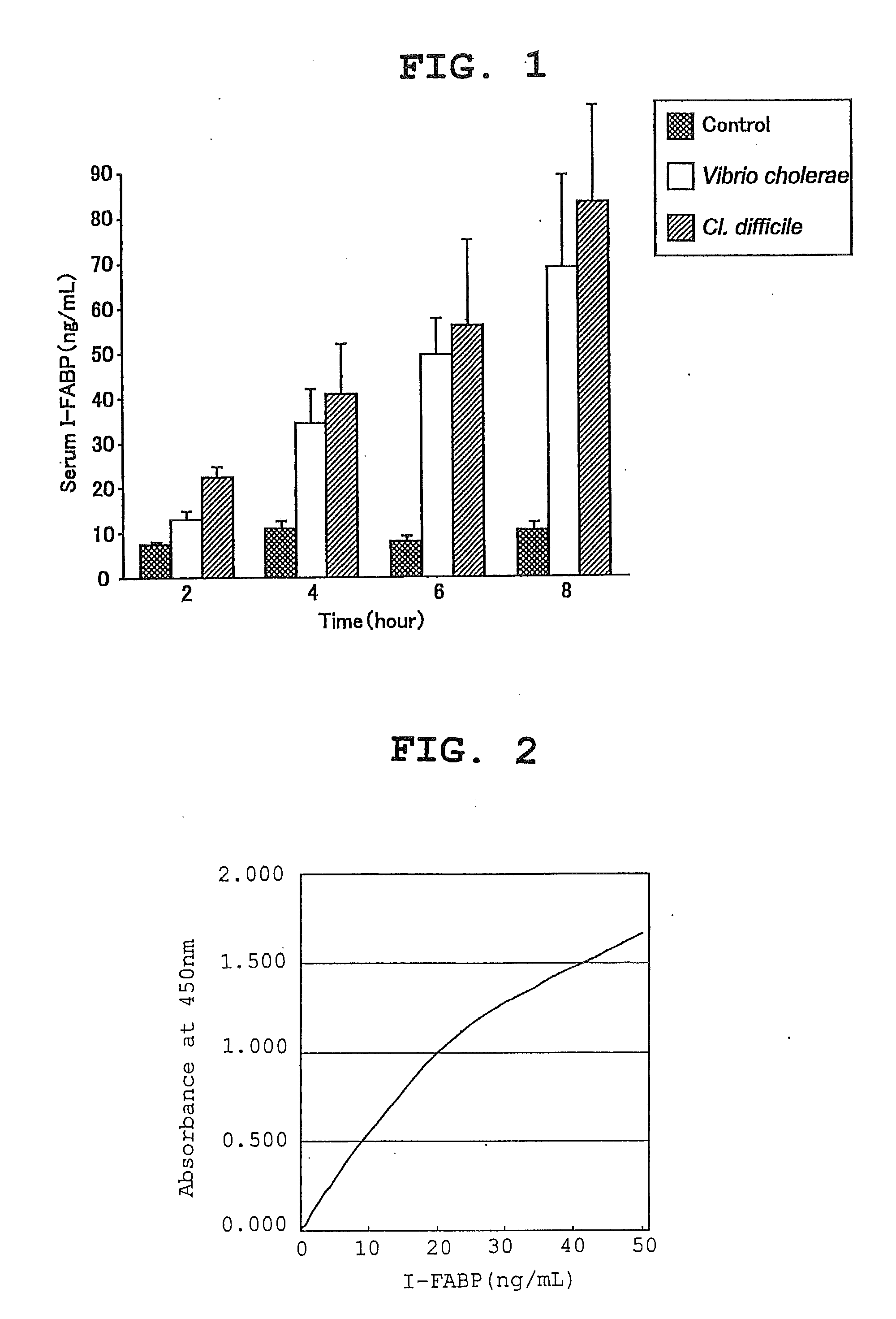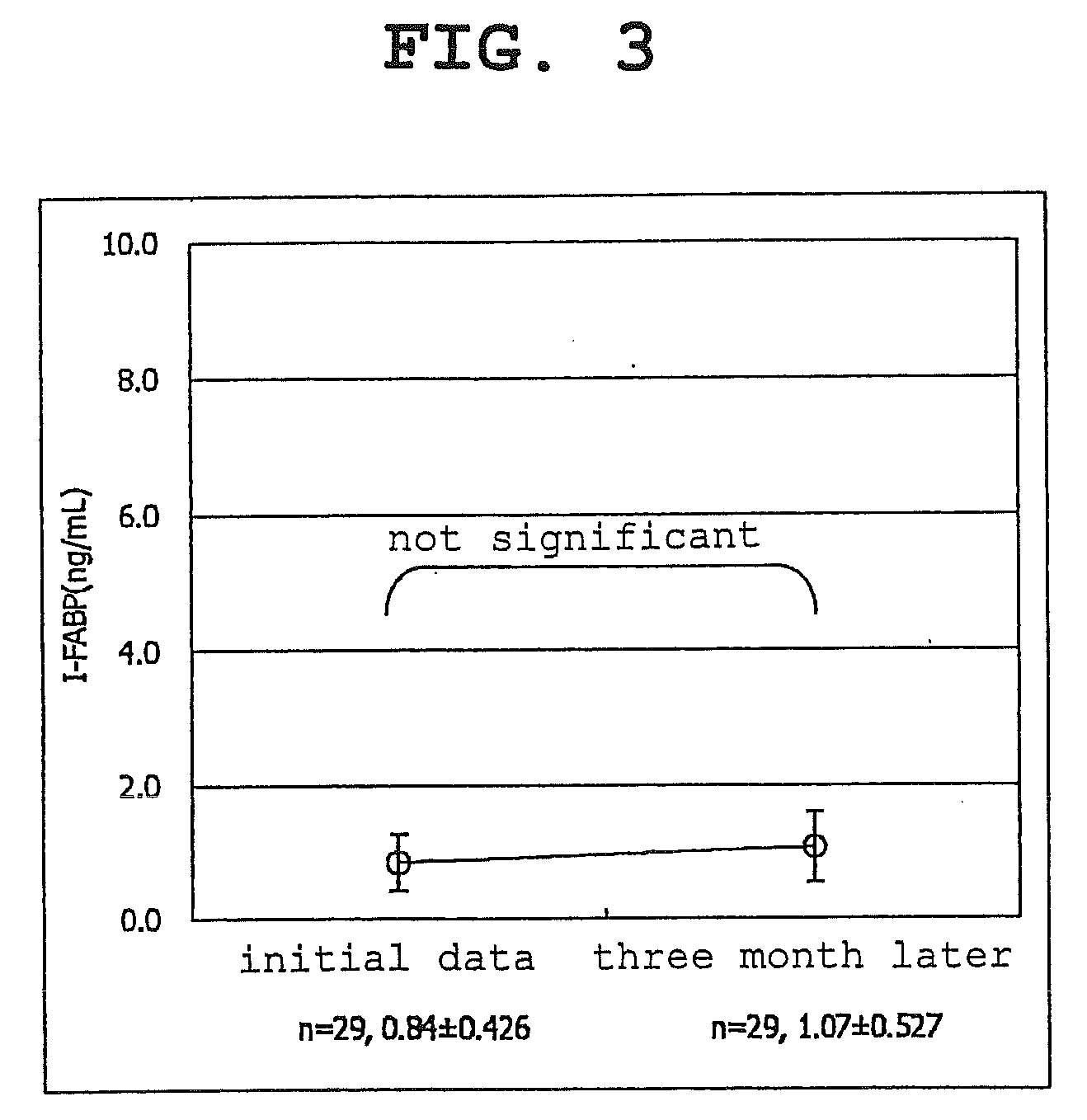Diagnosis of acute enterocolitis by determination of intestinal fatty acid-binding protein in the blood
a technology of acute enterocolitis and determination reagent, which is applied in the field of determination method and determination reagent for acute enterocolitis, can solve the problems of inability to definitively diagnose the disease, lack of definitive diagnostic procedure, and inability to accurately determine so as to achieve the goal of determining the pathological progress and treatment effect of acute enterocolitis, and achieving the goal of achieving objective and accurate determination results
- Summary
- Abstract
- Description
- Claims
- Application Information
AI Technical Summary
Benefits of technology
Problems solved by technology
Method used
Image
Examples
example 1
(A) [Acquirement of Rabbit Anti-Rat I-FABP Polyclonal Antibody]
[0054]An anti-rat I-FABP polyclonal antibody was acquired by the following procedure.
[0055]Small intestinal mucosa was collected from 60 SD rats (male) and, after homogenate extraction with Tris-HCl buffer (0.1 mol / L, pH 7.4, containing 1 mmol / L EDTA), purified by Sephadex G-75, DEAE-cellulose and Hydroxyapatite column to give purified rat I-FABP (15 mg). This was used as an antigen to immunize a rabbit. The amount of the antigen used was 100 μg for the first time and 50 μg for the second time onwards, which was suspended in Freund's adjuvant and used. The antibody titer of the rabbit serum was confirmed by gel double immunity diffusion method, and whole blood was collected and centrifuged at 3000 rpm×10 min to prepare the anti-serum.
[0056]From the obtained anti-serum, an anti-rat I-FABP specific polyclonal antibody could be obtained by Sepharose 6 MB chromatography using purified rat I-FABP solid-phased as a ligand. The...
example 2
[Measurement of Blood I-FABP in Acute Enterocolitis Rat Experimental Model]
[0062]The abdomen of SD rats (male) was opened under anesthesia and a jejunum ligation loop (15 cm) was prepared. They were divided into 3 groups: control group (n=8), V. cholerae group (n=8) and Cl. difficile group (n=8). Cholerae toxin (30 μg) for the V. cholerae group and Difficile A toxin 5×219 CU (Cytotoxic Unit) for the Cl. difficile group were dissolved in saline and injected into the respective loops. Blood samples were collected at 2, 4, 6 and 8 hours after the close of abdominal region, and the I-FABP level in serum was measured by a sandwich-type enzyme immunoassay using the anti-rat I-FABP polyclonal antibody described in Example 1.
[0063]The measurement results are shown in FIG. 1. The I-FABP level in serum was about 10 ng / mL in the control group throughout the entire progress. However, the I-FABP level increased with time in the enterocolitis group, and the 8 hr level was 68.2 ng / mL for the V. ch...
example 3
(A-1) [Acquirement of Rabbit Anti-Human I-FABP Polyclonal Antibody]
[0065]NZW rabbit (male) was immunized, at 2-week intervals, with 100 μg / rabbit for the first time and 50 μg / rabbit for the second time onwards of recombinant I-FABP (rI-FABP) obtained by expressing human I-FABP gene by baculovirus. After immunization, an aliquot of blood was sampled, and the degree of antibody titer was confirmed with the reactivity with solid-phased rI-FABP as an index. Then, whole blood was collected from the carotid artery under anesthesia, and the obtained blood was centrifuged at 3000 rpm×10 min and the blood cell fraction was removed to give anti-serum. The obtained anti-serum was subjected to ammonium sulfate fractionation, DEAE-cellulose purification and affinity purification to give a rabbit anti-human I-FABP polyclonal antibody.
(A-2) [Acquirement of Mouse Anti-Human I-FABP Monoclonal Antibody]
[0066]rI-FABP obtained by expressing human I-FABP gene by baculovirus was dissolved in saline, susp...
PUM
| Property | Measurement | Unit |
|---|---|---|
| time | aaaaa | aaaaa |
| pH | aaaaa | aaaaa |
| concentration | aaaaa | aaaaa |
Abstract
Description
Claims
Application Information
 Login to View More
Login to View More - R&D
- Intellectual Property
- Life Sciences
- Materials
- Tech Scout
- Unparalleled Data Quality
- Higher Quality Content
- 60% Fewer Hallucinations
Browse by: Latest US Patents, China's latest patents, Technical Efficacy Thesaurus, Application Domain, Technology Topic, Popular Technical Reports.
© 2025 PatSnap. All rights reserved.Legal|Privacy policy|Modern Slavery Act Transparency Statement|Sitemap|About US| Contact US: help@patsnap.com



